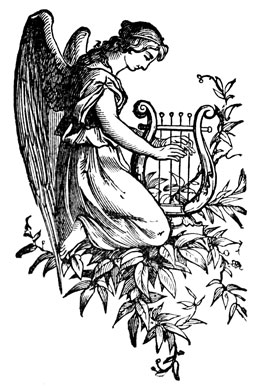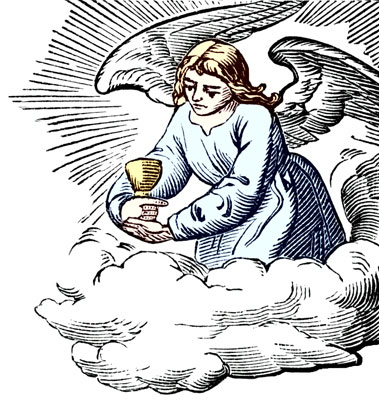The Supernatural in the Angelic World Supernatural Vocation of the Angels I. Holy Scripture hints that all the angels were called to the vision of God, when it represents the good angels as actually seeing His Face, and only excludes the fallen ones of from that privilege. Such is also the common tradition embodied in the opinion that man was called to fill the places left vacant by the fallen angels. . . . → Read More: Bible Angels: Part 4
|
|
|||
|
Number and Hierarchy of the Angels Number of the Angels I. We are certain, from Revelation. that the number of Angels is exceedingly great, forming an army worthy ot the greatness of God. This army of the King of heaven is mention in Deut. xxx. 2; then in the vision of Daniel (vii. 10), and in many other places. How Many Kinds? II. If the Angels can be numbered, there must exist between them at least personal differences; that is to say, each angel has his own personality. But whether they are all of the same kind, like man, or constitute several kinds, or are each of a different kind or species, is a question upon which Theologians differ. . . . → Read More: Bible Angels: Part 3 Attributes of the Angels—Incorruptibility and Relation to Space The attributes of the Angels, like the nature of their substance, are to be determined by a comparison with the attributes of God on the one hand, and with the attributes of man on the other. As creatures, the Angels partake of the imperfections of man; as pure spirits, they partake of the perfections of God. . . . → Read More: Bible Angels: Part 2 The Nature, Existence, and Origin of the Angels Terminology I. The name “ Angel”—that is, messenger or envoy—designates an office rather than a nature, and this office is not peculiar to the beings usually called Angels. Holy Scripture, however, and the Church have appropriated this name to them, because it represents them as standing between God and the rest of the universe, above man and nearer to God on account of their spiritual nature, and taking a share in the government of this world, although absolutely dependent on God. . . . → Read More: Bible Angels: Part 1 [Part 1] (6) In Human Form In the Scriptures angels appear with bodies, and in the human form, and no intimation is anywhere given that these bodies are not real, or that they are only assumed for the time and then laid aside. It was manifest indeed to the ancients that the matter of these bodies was not like that of their own, inasmuch as angels could make themselves visible and vanish again from their sight. But this experience would suggest no doubt of the reality of their bodies; it would only intimate that they were not composed of gross matter. . . . → Read More: Angels in the Bible: Part 2 Angel, is a word signifying messengers, both in Hebrew and Greek, and therefore used to denote whatever God employs to execute his purposes, or to manifest his presence or his power. In some passages it occurs in the sense of an ordinary messenger (Job i:14; I Sam. xi:3; Luke Vii:4; iX:52); in others it is applied to prophets (Is. lxiii:i9; Bag. i:13; Mal. iii); to priests (Eccl. v:5: Mal. ii:7); to ministers of the New Testament (Rev. i:20). It is also applied to personal agents; as to the pillar of cloud (Exod. xiv:19; xiii:21;xxxii:34); to the pestilence (2 Sam. xxiv:16, 17;2 Kings xix:30); to the winds (‘who maketh the winds his angels’ Ps. civ:4); so, likewise, plagues generally are called ‘evil angels’ (Ps. lxxviii:49), and Paul calls his thorn in the flesh an ‘angel of Satan’ (2 Cor. xii:7; Gal. iv:13, 14). . . . → Read More: Angels in the Bible: Part 1
Triumph of the Innocents by Holman Hunt [Part 1] [Part 2] [Part 3] In this front rank of great religious artists we must also place Mr. Holman Hunt, whose work has appealed so strongly to the popular mind, without any deliberate attempt on his part, however, to make it do so. His great picture, “The Triumph of the Innocents,” demands mention here for the beauty of the angelic children who, seen alone by the infant Christ, are accompanying the Holy Family to Egypt. The picture was at the Guildhall Exhibition a year or two ago, and is now in the Walker Art Gallery, Liverpool. . . . → Read More: Angel Art: Part 4 |
|||
|
Copyright © 2024 Christian Image Source - All Rights Reserved |
|||





 Angel Graphics
Angel Graphics
Archangels: Part 2
The earliest instance of the Archangels introduced by name into a work of art is in the old church of San Michele at Ravenna (A. D. 545). The mosaic in the apse exhibits Christ in the centre, bearing in one hand the cross as a trophy or sceptre, and in the other an open book on which are the words, “Qui cidef me videt et Patrem meum” [John xiv. 9]. On each side stand Michael and Gabriel, with vast wings and long scepters; their names are inscribed above, but without the Sanctus and without the Glory. It appears, therefore, that at this time, the middle of the sixth century, the title of Saint, though in use, had not been given to the Archangels. . . . → Read More: Archangels: Part 2